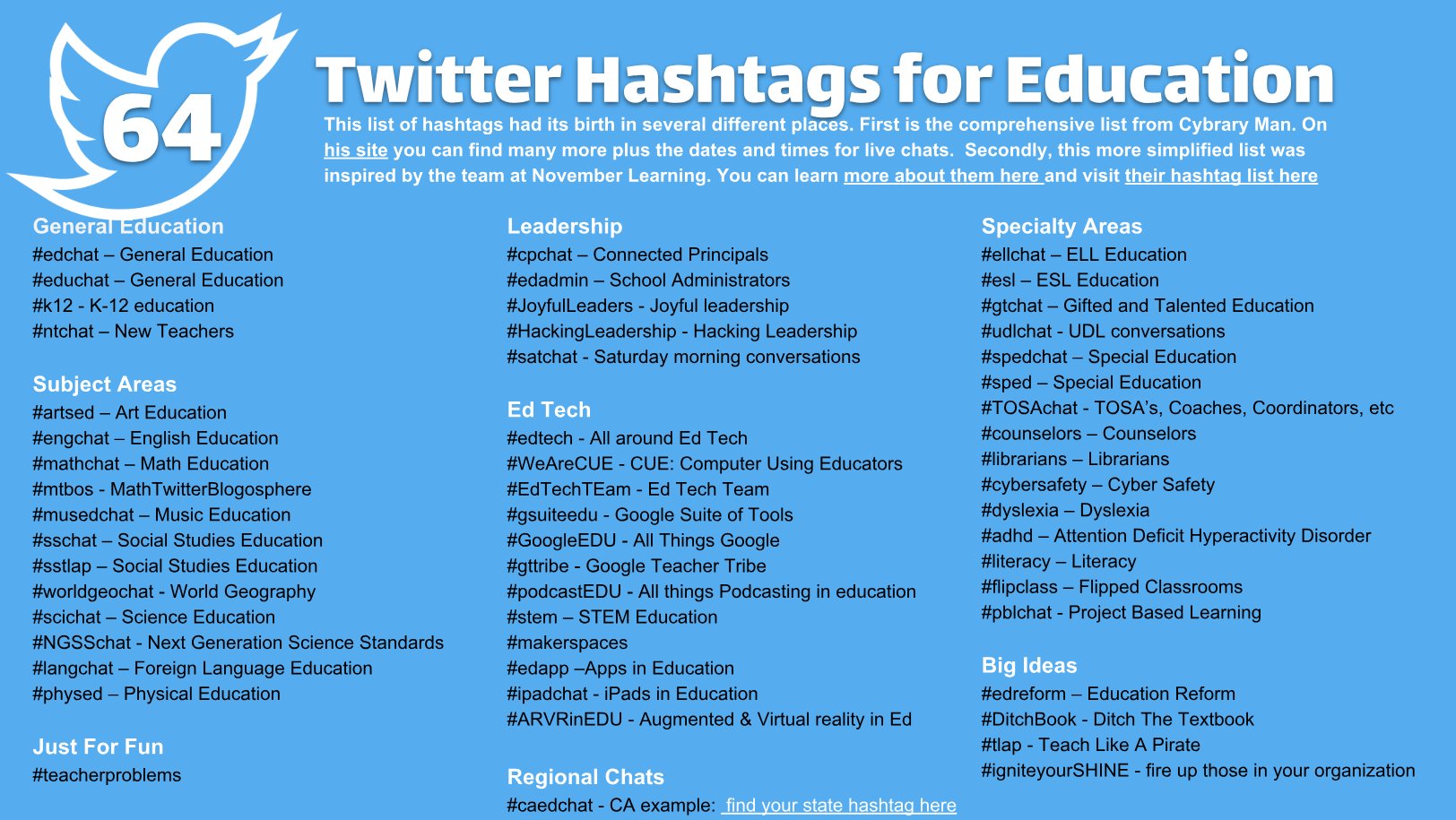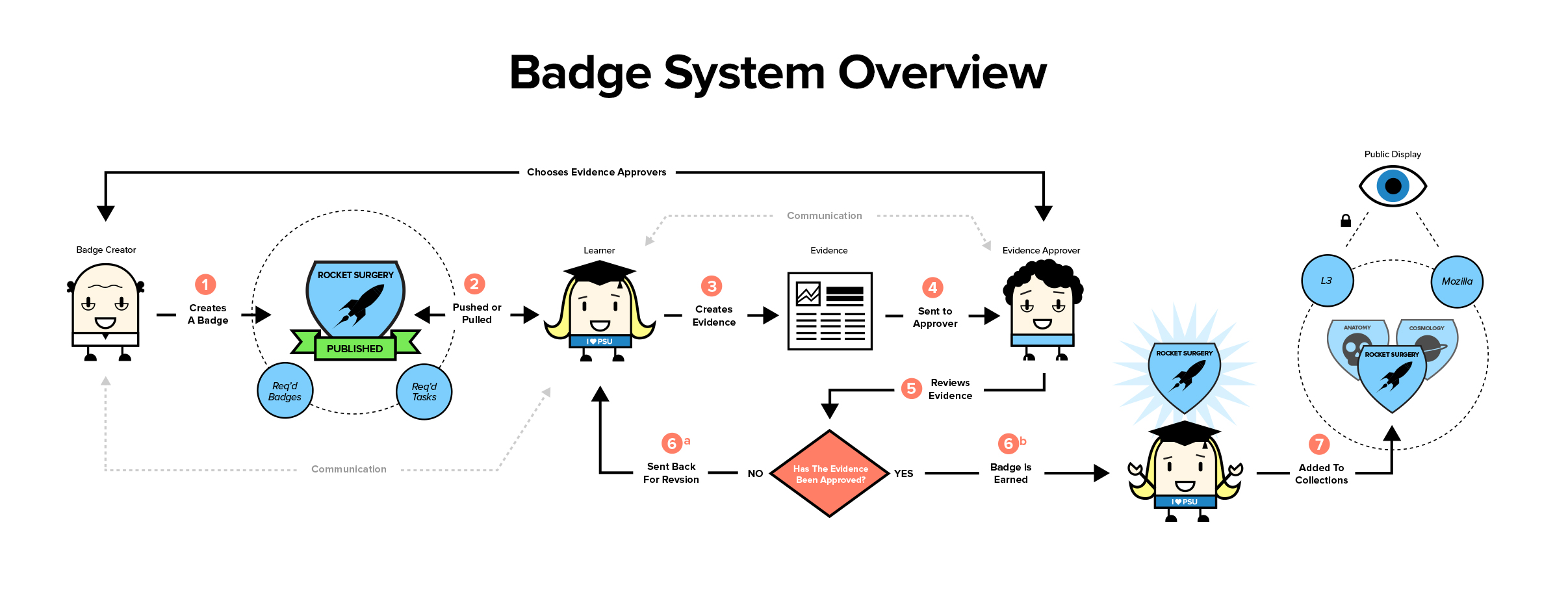twitter hashtags for education

Digital Literacy for St. Cloud State University

https://www.primaryresearch.com/AddCart.aspx?ReportID=505
The 100-page study presents data from 1,140 college students from 4-year colleges in the United States concerning their use of specialized library technology, group and individual study rooms. The report enables its end users to answer questions such as: which students use individual and group study rooms? Which use specialized technology rooms? How often do they use them?
Data in the report is presented in the aggregate and then broken out separately for sixteen different variables including but not limited to: college grades, gender, income level, year of college standing, SAT/ACT scores, regional origin, age, sexual orientation, race & ethnicity, college major and other personal variables, and by Carnegie class, enrollment size and public/private status of the survey participants institutions of higher education.
By: Kevin Yee, PhD, and Diane E. Boyd, PhD JUNE 18TH, 2018
We know now from rigorous testing in cognitive psychology that learning styles are really learning preferences that do not correlate with achievement (An et al., 2017).
https://www.facultyfocus.com/articles/teaching-and-learning/how-can-we-amplify-student-learning-the-answer-from-cognitive-psychology/
An, Donggun, and Martha Carr. “Learning styles theory fails to explain learning and achievement: Recommendations for alternative approaches.” Personality and Individual Differences 116 (2017): 410-416.
To assist time-strapped instructional faculty and staff, we offer a consolidated summary of key cognitive science principles, in the form of an easy-to-remember acronym: ANSWER.
Attention: Learning requires memory, and memory requires focused attention. Multitasking is a myth, and even the more scientifically-accurate term “task-switching” yields errors compared to focused attention. The brain is quite adept at filtering out dozens of simultaneous stimuli, as it does every second of wakefulness. Attention is a required ingredient for learning. This has ramifications for syllabus policies on the use of electronic devices for note-taking, which have been shown to be irresistible and therefore lead to distraction and lower scores (Ravizza, Uitvlugt, and Fenn). Even when students are not distracted, laptops are used primarily for dictation, which does little for long-term memory; writing by hand does more to stimulate attention and build neural networks than typing (Mueller and Oppenheimer).
Novelty: variety into lesson plans, activities, and opportunities for practice, instructors amplify potential learning for their students. Further, the use of metaphors in teaching enhances transfer, hemispheric integration, and retention, so using picture prompts and images can further solidify student learning (Sousa).
Spacing: Sometimes called “distributed practice,”the spacing effect refers to the jump in performance when students study a subject and then practice with gaps of time, ideally over one or more nights (sleep helps with memory consolidation), as compared to studying all at once, as if cramming the night before a test. Cramming, or massed practice, is successful for temporary test performance, since information is loaded into working memory. But the practices that work well for short-term memory do not work well for long-term memory. The spacing effect is particularly effective when combined with interleaving, the intentional practice of mixing in older learning tasks/skills with the new ones (Roedeiger, et al.). An ideal example of this would be regular quizzes in the semester that are cumulative (think “tiny final exams”).
Why: Memory is associative; when new memories are formed, neurons wire together (and later fire together), so the context can lead to the information, and vice versa. A teaching strategy of comprised of questions to guide lesson plans (perhaps even beginning with mystery) can pique student interest and learning potential. If you use PowerPoint, Haiku Deck, or Prezi, do your slides consist primarily of answers or questions?
Emotions: Short-term memories are stored in the hippocampus, a portion of the brain associated with emotions; the same area where we consolidate short-term into long-term memories overnight.
As instructors, we create the conditions in which students will motivate themselves (Ryan & Deci, 2000) by infusing our interactions with the positive emptions of curiosity, discovery, and fun. Simple gamification (quizzes with immediate feedback, for instance) can help.
Repetition: The creation of a new memory really means the formation of synapses across neurons and new neural pathways. These pathways and bridges degrade over time unless the synapse fires again. Consider the days before smartphones, when the way to remember a phone number was to repeat it several times mentally. Repetition, in all its forms, enables more effective recall later. This is why quizzing, practice testing, flashcards, and instructor-driven questioning and challenges are so effective.
+++++++++++
more on learning styles in this IMS blog
https://blog.stcloudstate.edu/ims?s=learning+styles
more on multitasking in this blog
https://blog.stcloudstate.edu/ims?s=multitasking
for and against the use of technology in the classroom
https://blog.stcloudstate.edu/ims/2017/04/03/use-of-laptops-in-the-classroom/
on spaced learning in this blog
https://blog.stcloudstate.edu/ims/2017/03/28/digital-learning/
Monday, June 11, 3PM
https://blog.stcloudstate.edu/ims?s=badges
https://blog.stcloudstate.edu/ims?s=microcredentialing
https://blog.stcloudstate.edu/ims/2016/06/20/colorados-digital-badging-initiative/
https://blog.stcloudstate.edu/ims/2016/04/11/digital-badges-in-education/
https://blog.stcloudstate.edu/ims/2016/09/14/badges-blueprint/
++++++++++++++++
From Gail Ruhland:
Guess what … I searched for Brenda Perea (in hopes of maybe getting some information on how they set up their system) … One of her current positions is with Credly … Do we still want to reach out to her?
https://www.linkedin.com/in/brendaperea/
https://www.linkedin.com/pulse/new-credential-field-guide-released-brenda-perea/
Johnathan Finkelstein: https://blog.stcloudstate.edu/ims?s=finkelstein
+++++++++++++++
Penn State Digital Badges: https://badgesapp.psu.edu/


http://www.personal.psu.edu/bxb11/blogs/brett_bixler_e-portfolio/2012/07/badges-at-penn-state.html
++++++++++++++++++
https://www.stonybrook.edu/commcms/spd/badges/index.php
October 29, 2015
Kaltura promo: https://learn.esc.edu/media/Ken+Lindblom%2C+Dean+of+the+School+of+Professional+Development%2C+Stony+Brook+University/1_wxhe9l4h
SUNY Micro-Credentialing Task Force Report and Recommendations: http://www.system.suny.edu/media/suny/content-assets/documents/faculty-senate/plenary/Microcredentialing-Report-Final-DRAFT—9-18-17.pdf
page 4, page 12-21
+++++++++++++++++++
+++++++++++++++++
https://www.universitybusiness.com/article/millennial-demand-drives-higher-ed-badging-expansion
Fields in which most badges have been issued:
94%: Institutions offering alternative credentials
1 in 5: Colleges and universities that issue badges
Nearly 2/3: Institutions that cited alternative credentials as an important strategy for the future.
-Source: “Demographic Shifts in Educational Demand and the Rise of Alternative Credentials,” University Professional and Continuing Education Association and Pearson, 2016
Scapple
https://www.literatureandlatte.com/scapple/overview
https://mashable.com/2018/06/01/mind-mapping-tool-scapple/
+++++++++++
more on mind mapping in this IMS blog
https://blog.stcloudstate.edu/ims/2014/12/14/mindmapping/
From FYE to ROI to HIP, librarians are seeing new acronyms emerge in their campus administrations’ initiatives. How can today’s academic libraries position themselves to improve student success and retention, using high-impact practices (HIPs) to demonstrate a return-on-investment (ROI)? Many libraries struggle to define and implement their services in a way that meets these shifting expectations.
Wednesday, June 13, 2018 2:00 PM Eastern 1:00 PM Central12:00 PM Mountain 11:00 AM Pacific
To register: https://goo.gl/EhzBRi
++++++++++
more on ROI in this IMS blog
https://blog.stcloudstate.edu/ims?s=return+on+investment
https://www.freetech4teachers.com/2018/05/three-ways-to-develop-programming.html
+++++++++++++++++++++++++
more on coding in this IMS blog:
We spend hours in front of our computers and phones, and the repetitive movement patterns can cause neck and shoulder strain. This sequence will help.
GARY KRAFTSOW FEB 8, 2016https://www.yogajournal.com/practice/healing-yoga-sequence-ease-neck-shoulder-pain
+++++++++++++++++++
more on contemplative computing in this IMS blog
https://blog.stcloudstate.edu/ims?s=contemplative
SUBSCRIBE FOR THE YOUTUBE CHANNEL WITH ALL VIDEOS BELOW
https://www.youtube.com/channel/UCr6jv43PYW-FQDlSbxFQg9g
June 20:
June 18:
https://www.facebook.com/InforMediaServices/posts/1572411372869354
June 13 work in the lab:
Facebook Live: June 13, 2018: https://www.facebook.com/InforMediaServices/videos/1562686293841862/